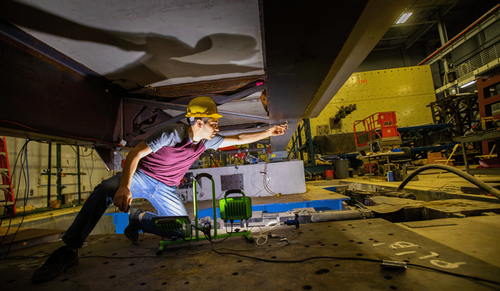THURSDAY, MAY 11, 2023
Researchers from the School of Engineering at the University at Buffalo will receive funding to apply new technologies to precast concrete and explore ways to create more durable and long-lasting transportation infrastructure.
The newly created Transportation Infrastructure Precast Innovation Center (TRANS-IPIC) was awarded $10 million from the U.S. Department of Transportation over a five-year period, over which UB will reportedly receive $1.6 million.
About the Research
The center will incorporate new technologies into precast concrete, according to Pinar Okumus, an associate professor at UB, who will serve as an associate director for TRANS-IPIC.
“Precast concrete bridges make up most of the new bridges in the U.S. Precast concrete is also common for other infrastructure elements such as tunnels, airports and railroads. They are preferred over alternatives because precast concrete structures can be rapidly built, greatly reducing traffic delays and detours associated with construction,” Okumus said.
“Because precast concrete is used often, enhancing the quality of the materials, construction methods and monitoring methods for precast concrete structures will have a big impact on the U.S.’s infrastructure.”

 |
| University of Buffalo |
|
Researchers from the School of Engineering at the University at Buffalo will receive funding to apply new technologies to precast concrete and explore ways to create more durable and long-lasting transportation infrastructure. |
Precast concrete requires less maintenance and can potentially last longer than typical concrete cast during construction, the university says. Precast elements are built off-site, where the controlled environment helps to create an ideal space to implement new technologies into the precast concrete.
Bassem Andrawes, a professor at the University of Illinois Urbana-Champaign, is leading the five-university consortium. Okumus is the principal investigator at UB and is aided by researchers at other schools such as Purdue University and Louisiana State University. UB researchers will also reportedly collaborate with center partners.
According to Okumus, researchers at UB will most likely work in several specialty areas.
“We have expertise in material science, concrete structures, bridge and tunnel engineering, robotics, health monitoring, performance-based engineering and additive manufacturing. We are excited to initiate projects related to these areas,” Okumus says.
One of the centers aims to advance the additive manufacturing technology for bridge construction around two pillars: materials and manufacturing. Additive manufacturing is 3D printing an object from a computer-aided design.
Chi Zhou, an associate professor at UB, will reportedly lead the development and analysis of printable multifunctional material and the effort to convert the material into scaled 3D bridge elements.
“My goal in the center is to advance the additive manufacturing technology for bridge construction by making the bridge builds faster, smarter and more resilient,” Zhou says.
“I intend to study the printability of multifunctional materials, design the automation and control modules, and develop 3D printing systems for the bridge construction.”
Dr. Ravi Ranade, associate professor at UB in the Department of Civil, Structural, and Environmental Engineering, specializes in advanced cementitious materials. Ranade is also a member of the Institute of Bridge Engineering (IBE) and, along with several IBE faculty, is an investigator with the TRANS-IPIC.
“I have significant experience working with the high-performance concrete materials. We have worked on developing several versions of UHPC for the Army Corps of Engineers in a variety of applications,” Ranade says.
“I was involved in developing one of the first UHPCs for 3D printing in the world with collaborators at Swinburne University, Australia.”
The center will also reportedly include educational and technology transfer activities, supporting IBE’s existing efforts to provide practicing engineers with the skills and knowledge needed to advance bridge infrastructure.
Other UB investigators are Associate Professor Negar Elhami-Khorasani; Assistant Professor Xiao Liang; Associate Professor Anthony Tessari; and SUNY Distinguished Professor and IBE director Andrew Whittaker. The investigators are in the Department of Civil, Structural and Environmental Engineering and IBE affiliates.
The University Transportation Center program is focused on advancing transportation research and technology and developing the next generation of transportation professionals.
Other Recent UB Research
In March, UB began preparations for what is being called the largest-ever United States earthquake test of a brick and mortar building, with hopes of making structures more earthquake-resistant.
Researchers anticipate findings from this project will directly influence the American Society of Civil Engineers (ASCE) standard 41, which is titled "Seismic Evaluation and Retrofit of Existing Buildings."
Unreinforced masonry (URM) buildings commonly house residences, stores, restaurants, schools, fire departments and other critical infrastructure, but are susceptible to seismic vulnerability.
However, despite this construction being banned in California after damage suffered during the 1933 Long Beach earthquake, many URM buildings remain in California and other U.S. cities. Many of these buildings also reportedly have historical significance.
According to the university, the research group plans to develop a framework for the design of reliable and cost-effective retrofit methodologies suitable for these structures. This includes the ASCE standard 41, which uses different performance-based methodologies to evaluate and improve, or retrofit, the performance of existing buildings during earthquakes.
Tagged categories: 3D Printing; Bridges; Bridges; Colleges and Universities; concrete; Construction; Department of Transportation (DOT); Engineers; Infrastructure; Infrastructure; Program/Project Management; Research; Research and development; Technology; Transportation